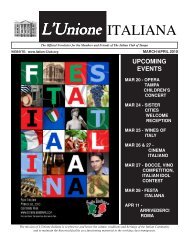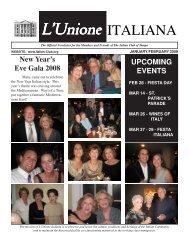May - June 2008.pmd - The Italian Club of Tampa
May - June 2008.pmd - The Italian Club of Tampa
May - June 2008.pmd - The Italian Club of Tampa
You also want an ePaper? Increase the reach of your titles
YUMPU automatically turns print PDFs into web optimized ePapers that Google loves.
MAY/JUNE 2008<br />
Continued from page 11.<br />
Sanford traveled to Italy and, on<br />
September 7 th , 1861, went down to<br />
the Genoa waterfront and – using an<br />
assumed name to preserve the<br />
secrecy <strong>of</strong> his mission- chartered a<br />
small steamer named the Dante to<br />
carry him to Caprera. Garibaldi<br />
accepted, but upon two conditions:<br />
He ardently desired to serve the<br />
cause <strong>of</strong> the United States, but as<br />
commander in Chief <strong>of</strong> its forces<br />
and with power <strong>of</strong> declaring the<br />
abolition <strong>of</strong> slavery. Sanford<br />
explained that he was only<br />
empowered to <strong>of</strong>fer the two-star<br />
generalship as set forth by Secretary<br />
Seward, and he could not go beyond<br />
it.<br />
When this negotiation failed<br />
to stay secret, many in Europe,<br />
including England who at that time<br />
sympathized with the Confederates,<br />
stressed this issue <strong>of</strong> command<br />
levels as the main reason why<br />
Lincoln and Garibaldi couldn’t<br />
agree. I think this explanation is<br />
partial and misleading. As a matter<br />
<strong>of</strong> fact, Garibaldi was <strong>of</strong>fered the<br />
two-star generalship, i.e., the same<br />
level <strong>of</strong> McClellan with only<br />
President Lincoln and the Federal<br />
Civil Administration above him.<br />
Emancipation <strong>of</strong> slavery – a lifetime<br />
goal for Garibaldi – was surely as<br />
important as the command issue. In<br />
his reporting to Washington,<br />
Sanford wrote; “I do not believe he<br />
will take any part in the struggle<br />
unless he is convinced that the<br />
government and the people <strong>of</strong> the<br />
North are united in the<br />
determination to pursue a policy<br />
which shall necessarily result in the<br />
abolition <strong>of</strong> slavery.”<br />
In my opinion, however, the<br />
main reason for Garibaldi not to<br />
fight for the Union was a third one:<br />
he felt he still had to finish the<br />
unification <strong>of</strong> Italy. Garibaldi tried<br />
again to march towards Rome<br />
starting from Sicily in summer<br />
1862, with his Red Shirts. This time<br />
he was stopped, indeed wounded<br />
and arrested, by the regular <strong>Italian</strong><br />
Army on the Aspromonte<br />
Mountains, Calabria. <strong>The</strong> window<br />
<strong>of</strong> opportunity for Garibaldi to join<br />
the Union Army was closed.<br />
Although Garibaldi never<br />
fought in the Civil War, his name is<br />
nonetheless rooted in the earliest<br />
days <strong>of</strong> the conflict’s history.<br />
Shortly after the Confederate<br />
bombardment <strong>of</strong> Fort Sumter in<br />
Charleston, South Carolina, <strong>Italian</strong><br />
Americans in New York<br />
volunteered to form a regiment <strong>of</strong><br />
Red Shirts, the 39 th NY Infantry<br />
“Garibaldi Guards.” <strong>The</strong> regiment<br />
marched to Washington and<br />
fought in the first battle <strong>of</strong><br />
Manassas-Bull Run in July 1861,<br />
carrying Garibaldi’s legacy into<br />
battle with them.<br />
In 1882 <strong>Italian</strong>s living in Washington, D.C., formed the Society for a Monument to<br />
Garibaldi following the death <strong>of</strong> Giuseppe Garibaldi that same year. <strong>The</strong>y<br />
commissioned an <strong>Italian</strong> artist living in Paris, Giuseppe Martegana, to create a bust<br />
to commemorate the patriot. <strong>The</strong> group presented a letter to the president <strong>of</strong> the<br />
Senate dated December 14, 1887, from Dr. Tullio de Suzzara-Verdi <strong>of</strong>fering the<br />
Garibaldi bust, which was executed in <strong>Italian</strong> marble, to the United States. He asked<br />
on behalf <strong>of</strong> the society that it be accepted, “as a link in the chain <strong>of</strong> sympathy that<br />
all free men feel for the champions <strong>of</strong> liberty and popular government.” <strong>The</strong> work<br />
also was presented as an expression <strong>of</strong> <strong>Italian</strong> achievement in sculpture.<br />
On August 23, 1888, the U. S. Senate approved the acquisition, resolving that “the<br />
Senate <strong>of</strong> the United States expresses its sense <strong>of</strong> the patriotism and liberality which<br />
prompted this noble gift from these adopted citizens <strong>of</strong> <strong>Italian</strong> birth, and extends to them, the countrymen <strong>of</strong> the<br />
great champion <strong>of</strong> <strong>Italian</strong> liberty, the assurance <strong>of</strong> the admiration <strong>of</strong> the people <strong>of</strong> this land for his noble life and<br />
distinguished deeds.”<br />
For additional information please visit Italy’s web site for the Bicentennial at: http://garibaldi200.it/<br />
PAGE 22
















